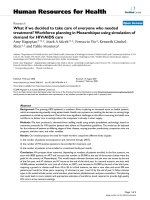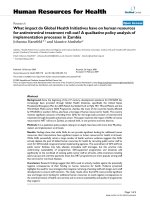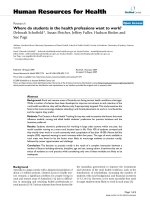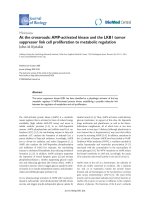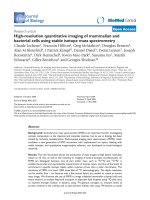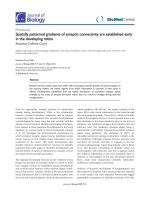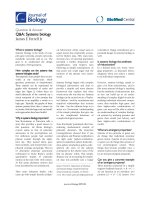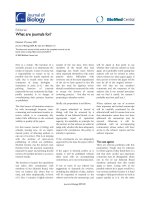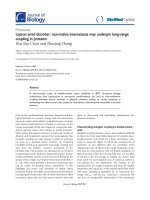Báo cáo sinh học : "What do we know about influenza and what can we do about it" ppsx
Bạn đang xem bản rút gọn của tài liệu. Xem và tải ngay bản đầy đủ của tài liệu tại đây (148.86 KB, 4 trang )
Question and Answer
QQ&&AA:: WWhhaatt ddoo wwee kknnooww aabboouutt iinnfflluueennzzaa aanndd wwhhaatt ccaann wwee ddoo aabboouutt iitt??
Peter C Doherty*
,†
and Stephen J Turner*
IInnfflluueennzzaa ppaannddeemmiiccss ooccccuurr wwhheenn
hhuummaann ppooppuullaattiioonnss aarree iinnffeecctteedd bbyy
aa vvaarriiaanntt vviirruuss ttoo wwhhiicchh aa
ppooppuullaattiio
onn hhaass nnoo pprriioorr iimmmmuunniittyy
WWhhaatt aarree tthhee ccrruucciiaall vvaarryyiinngg
ggeenneess??
The crucial genes are those encoding
the two viral surface proteins hema-
gglutinin (H or HA) and neuramini-
dase (N or NA). The influenza A
viruses [1] that infect mammals like us
replicate principally in the epithelial
cells of the airways. The HA facilitates
viral entry by binding to sialic acid
residues on the epithelial cell surface,
while the NA functions to cleave such
attachments, and so release new virus
particles, or virions, both from the cell
and from the slimy mucous that
protects the lung and trachea. The new
virions are then free to spread the
infection, both from cell to cell and to
other susceptible individuals. Anti-
bodies that bind to either the HA or
the NA and block their function effec-
tively prevent (or terminate) the
infectious process and thus provide
protective immunity. The anti-influ-
enza drugs zanamivir and oselatamivir
(Relenza and Tamiflu) operate by
blocking the NA active site and, as this
was first characterized by the structural
analysis of NA-antibody complexes,
are among the earliest examples of
rational drug design.
The variability of the HA and NA
proteins is due to lack of proof
reading by the viral polymerase that
leads in turn to poor fidelity of
genome copying and frequent occur-
rence of mutations. The resulting
virus variants are then subjected to
selective pressure by neutralizing
(blocking) antibodies produced by
immune individuals, leading to the
emergence of so-called escape
mutants that are not detected by
antibodies against the original virus
and cause annual, or biennial,
‘seasonal’ influenza outbreaks. Such a
virus can spread across the USA
within a single month.
New HA and NA types also enter the
human population as a consequence
of genetic reassortment between, for
example, viruses that have been
circulating in humans and those that
circulate in birds. The influenza virus
genome is organized in eight discrete
segments and, if a single cell is
infected simultaneously with a
‘human’ and an ‘avian’ virus, the
segments can become re-packaged to
give a novel variant that could, for
instance, express completely new (to
humans) avian HA or NA types but
whose other genes remain adapted to
enable them to spread in people.
Aquatic birds, which are the main
reservoir of the influenza A viruses, are
known to carry 16 different HAs and 9
NAs. Pigs, which can be infected with
both avian and human viruses, are
thought commonly to be the host
from which reassortant influenza
viruses emerge (Figure 1).
The three viruses that circulated in
people through the 20
th
century were
H1N1, H2N2 and H3N2. These
crossed over into humans some time
before 1918 (H1N1), in 1957 (H2N2)
and in 1968 (H3N2), with all three
causing pandemics. By far the worst
was the 1918 H1N1 virus that killed
some 40-70 million in a global popu-
lation that was less than a third the
size of that today. Though the first
human influenza A virus was not
isolated until 1933, the 1918 virus has
been reconstructed by PCR from pre-
served lung tissues and from exhum-
ing people who were buried in the
Alaskan permafrost. Extremely viru-
lent in rodents, ferrets and non-human
primates, it has the characteristics of a
mutant bird virus. Both the H2N2
“Asian ‘Flu” and the 1968 “Hong Kong
‘flu” are though to have originated by
reassortment between mutant duck
viruses and human viruses, with swine
being the adapting host.
There is ample evidence that the
H1N1 and H3N2 viruses have gone
back and forth between humans and
pigs, with the current ‘swine’ H1N1
being, perhaps, a descendant of the
1918 ‘human’ virus. Some 12 cases of
human infection with H1N1 viruses
that have ‘human’, ‘swine’ and ‘avian’
genetic elements have been recognized
in the USA since 1998, with 5,123 US
cases identified to May 19 in the
present outbreak (the world total of
confirmed cases in 40 countries to that
date being 9,830) [2]. Other viruses
(for example, H9N2, H7N7 and H5N1)
jump occasionally and cause severe
Journal of Biology
2009,
88::
46
*
Department of Microbiology and Immunology,
The University of Melbourne, Victoria 3010,
Australia.
†
Department of Immunology,
St Jude Children’s Research Hospital,
Memphis, TN 31805, USA.
Correspondence to Peter C Doherty:
disease in humans infected directly
from birds, but have not to date been
transmitted between humans.
WWhhaatt ddeetteerrmmiinneess wwhheetthheerr nneeww
aanniimmaall vviirruuss vvaarriiaannttss tthhaatt ccaann ppaassss
ffrroomm aanniimmaallss ttoo hhuummaannss ccaann aallssoo
bbee t
trraannssmmiitttteedd ffrroomm hhuummaann ttoo
hhuummaann??
The primary factor is the sialic acid on
the galactose on the surface of
respiratory tract epithelial cells. HAs of
human or pig viruses preferentially
recognize sialic acid bound to galac-
tose via an α2,6 linkage, while the
bird virus HAs recognize an α2,3
linkage. Humans express only the
α2,6 form in the upper respiratory
tract, and the α2,3 forms only deep in
the human lung (along with the α2,6
forms) [3]. Thus, breathing in a
relatively light dose of an avian virus
such as the H5N1 virus is unlikely to
lead to infection, and it is thought that
the occasional, often lethal (>60%)
case of human H5N1 virus pneumonia
results from very close exposure to an
infected bird, allowing virus penetra-
tion to the bronchi and bronchioles.
The characteristics of the sialic acid
linkage do not, however, seem to be
the sole determinant limiting inter-
species spread. Transmission experi-
ments with ferrets, which have a
receptor distribution comparable to
that found in humans, suggest that
changes in other genes may also be
critical for determining infectivity.
There is emerging evidence that
elements of the three-component viral
polymerase complex (PB1 and PB2)
can influence transmissibility [4],
though the underlying mechanism of
host specificity in this case is not clear.
CCaann tthhee aabbiilliittyy ooff aa vviirraall vvaarriiaanntt ttoo
ppaassss ffrroomm hhuummaann ttoo hhuummaann bbee
pprreeddiicctteedd ffrroomm iittss nnuucclleeiicc aacciidd
sse
eqquueennccee??
This may be possible in the future and
progress is being made in identifying
conserved amino acid sequences asso-
ciated with past pandemics [5] but we
don’t yet know enough about what
determines infectivity and virulence to
predict the key correlates of trans-
missibility just from the viral RNA
sequence.
WWhhaatt ddeetteerrmmiinneess tthhee sseevveerriittyy ooff
ddiisseeaassee ccaauusseedd bbyy aa ggiivveenn iinnfflluueennzzaa
vviirruuss??
The severity of influenza reflects both
the characteristics of the infecting virus
and host factors. Important host factors
include age, basic health status and
prior exposure to the same or related
viruses, with the very young, the
elderly, pregnant women and those
who are otherwise clinically compro-
mised being particularly susceptible in
non-pandemic, seasonal influenza
outbreaks. Secondary bacterial infec-
tion can also play a major part and
there is a good case for ensuring that
groups at greatest risk are given both
influenza and pneumococcal vaccines.
The nature of the early immune
response to the virus is widely believed
to be a major factor: paradoxically, the
more vigorous it is, the greater the risk
of mortality. Neutralizing antibodies,
which are purely protective, take several
days to produce. But so-called innate
immune defenses are activated within
minutes to hours of infection [6], and
involve the production of inflam-
46.2
Journal of Biology
2009, Volume 8, Article 46 Doherty and Turner />Journal of Biology
2009,
88::
46
FFiigguurree 11
Antigenic drift and antigenic shift in different hosts of influenza virus. The surface hemagglutinin
and neuraminidase molecules (blue) of influenza viruses undergo frequent mutation (antigenic
drift) in their human hosts, giving rise to new variants (red dots) that can elude antibodies made
in many individuals against the parent virus. Less frequently, entire segments of the eight-segment
genome of an avian influenza virus and a human virus become reassorted into the same virion,
usually through infection of swine by both viruses, and this can result in a virus that is still adapted
to infect humans but expresses an avian hemagglutinin or neuraminidase (antigenic shift) to which
there is no prior immunity in human populations. Figure reproduced with permission from Figure
10-17 of: DeFranco AD,
et al
.
Immunity
Oxford University Press; 2007.
Influenza
Epidemic
strain
Pandemic
strain
matory cytokines that cause increased
vascular permeability and edema, as
well as an influx of immune cells
causing tissue destruction, with
disastrous consequences for lung
function. Such a so-called cytokine
storm effect was first recognized in
people infected with an avian H5N1
virus, and is likely to have been at least
part of the reason for the excessive
death rates in otherwise healthy young
adults during the 1918 pandemic.
Other factors affecting virulence are
the production of viral proteins
capable of inhibiting host antiviral
mechanisms - for example, the NS1
protein produced by the influenza
virus inhibits the production of type I
interferon, which is normally induced
by viral infection and in turn induces
cellular anti-viral proteins that inter-
fere with viral replication; and we
have already mentioned the HA and
the NA, and members of the viral
polymerase complex. Apart from their
effects on viral infectivity and replica-
tive capacity, the way that these genes
operate to cause more severe disease is
poorly understood.
CCaann tthhee ppaatthhooggeenniicciittyy ooff aann
iinnfflluueennzzaa vviirruuss bbee ddeetteerrmmiinneedd
ffrroomm iittss ggeennoommee sseeqquueennccee??
Not yet, maybe some day.
WWhhyy ddooeess iitt ttaakkee ssoo lloonngg ttoo mmaakkee
aa vvaacccciinnee aaggaaiinnsstt aa nneeww iinnfflluueennzzaa
vviirruuss vvaarriiaanntt??
The first decision that has to be made
is: which vaccine? Vaccines that are
used against seasonal influenza are
based on the three most prevalent
circulating influenza viruses. A
comprehensive, international ‘virus-
watch’ program based administra-
tively in WHO Geneva co-ordinates
the operations of four WHO Colla-
borating Centers (London, Melbourne,
Tokyo, Atlanta) and a host of National
Laboratories. A combination of RT-
PCR and rapid sequencing is used for
the rapid characterization of viruses in
human circulation and that infor-
mation is made available globally. A
key WHO committee meets twice each
year to decide which influenza A and
B viruses will be included in the three-
component (H1N1, H3N2, influenza
B) vaccines manufactured commercially
for use in the Northern and Southern
hemispheres. Of course, this dynamic
changes immediately when a new
virus, like the current ‘swine’ H1N1,
suddenly enters the human popu-
lation raising the possibility that a
new vaccine must be produced.
The most efficient, in terms of the
amount of product required, are the
so-called live-attenuated vaccines that
have been adapted to replicate poorly
so that they do not cause disease. Live-
attenuated influenza virus vaccines
were long in use in the former Russian
Federation, but their broader availa-
bility is comparatively recent. Any
vaccine that is capable of some
replication has the advantage that it
can be used at lower titer, but the
disadvantage that its safety is less
secure than that of a killed one. For
this reason, such vaccines are not
currently recommended for the very
young or the elderly. There is also the
difficulty that, if there is any cross-
reactive neutralizing antibody, the
vaccine dose will be too low to boost
immunity. Attempts at making recom-
binant protein vaccines for influenza
have so far been unsuccessful,
principally because the proteins do
not fold appropriately.
The more commonly used killed
vaccines are made from viruses in-
activated in formalin or β-propio-
lactone and used either as a whole
virus or as a so-called split virus, in
which the viral components are
disrupted, or from which the HA and
NA subunits are purified. High titer
stocks are required as starting material
for such vaccines. Although efforts are
being made to develop cell-culture
systems for producing large amounts
of influenza virus, the optimal ‘culture
flask’ is still the hen’s egg. This
requires large numbers of eggs and a
specialized production facility, neither
rapidly scalable, with such operations
currently being used for about 6
months a year to produce sequentially
the three batches of different viruses
that go into the standard trivalent
vaccine. If the new ‘swine’ H1N1 virus
continues to spread and evolve, and is
as different as it seems to be from the
long-circulating ‘human’ H1N1
viruses, then we may need to think in
terms of incorporating a fourth compo-
nent, adding to the time required.
The vaccine reserve that was made to
combat the possible H5N1 threat took
even longer, because the H5N1 viruses
were so virulent that they killed chick
embryos before much virus was made,
and new recombinant vaccine viruses
had to be made by inserting the H5
and N1 into one of the standard
vaccine strains. Even though it was
inactivated, this ‘genetically modified
organism’ had to go through the full
range of phase 1 to 3 trials before it
could be approved for human use.
As it is, the world has, with a current
population of about 6.8 billion, never
made more than about 400 million
doses of trivalent influenza vaccine.
For this reason, a great deal of current
research is focused on identifying
improved adjuvants - substances that
increase the strength of the immune
response, so that the vaccine is more
effective and smaller amounts of viral
protein are required [7].
WWoouulldd iitt bbee ppoossssiibbllee iinn pprriinncciippllee
ttoo mmaakkee aa vvaacccciinnee tthhaatt wwoouulldd
pprrootteecctt aaggaaiinnsstt aannyy nneeww iinnfflluueennzzaa
vviir
ruuss vvaarriiaanntt??
The holy grail with influenza immuni-
zation, and for those trying to make
vaccines against HIV and hepatitis C
/>Journal of Biology
2009, Volume 8, Article 46 Doherty and Turner 46.3
Journal of Biology
2009,
88::
46
virus, is to identify a component of
the virus that is both accessible to
antibody and cannot be changed
because it plays some key functional
role for the virus. It is possible to
make monoclonal antibodies in the
laboratory (mAbs) that prevent infec-
tion by binding to a highly conserved
pocket in the HA stem region [8].
Analogous mAbs have been found for
HIV. What we don’t yet know,
however, is how to make a vaccine
that induces the human immune
system to make these antibodies. Even
so, mAbs produced artificially might
be used for therapy or prophylaxis in
the face of a novel, rapidly spreading,
severe influenza pandemic. In the
absence of a vaccine, it would be
much more realistic to give, say, front-
line medical personnel a monthly
dose of a protective, humanized mAb
rather than daily treatment with anti-
viral drugs. The advantage of such an
approach is that the mAbs could be
stockpiled ahead of time, instead of
having to be made anew each year,
because the target site on the HA does
not change.
IIss tthheerree aannyy ootthheerr wwaayy ttoo mmaakkee aa
bbrrooaaddllyy pprrootteeccttiivvee vvaacccciinnee??
When it comes to cross-reactive
immunity, a possible target is the
conserved, low abundance M2e
protein (a proton selective channel)
on the surface of the virion.
Immunization with M2e has some
protective efficacy in mice [9], but it is
not clear whether this approach will
work in humans. Another possibility
is to develop a vaccine that instead of
inducing antibodies activates the
production of cytotoxic T lympho-
cytes. These effector T cells recognize
and destroy virus-infected cells, which
betray the infecting virus by displaying
peptides derived from viral compo-
nents bound to self-major histo-
compatibility complex molecules that
are expressed on the surface of all
cells. Because these peptides are often
derived from conserved internal
components of the virus, a vaccine
based on them should be effective
against many viral variants. This
strategy has been shown to provide
some cross-protection against HA- and
NA-different viruses in mice [10].
Such immunity is not immediate,
however, because the T cells must be
reactivated from a resting/memory to
an effector/cytotoxic state on re-
exposure to the virus. The net conse-
quence in mice is more rapid virus
clearance and less severe disease.
Many practical and regulatory issues
arise, however, in connection with
such a possible partially protective
vaccine. Perhaps the T cell and M2e
approaches might be combined in one
product to provide a strategic reserve
that could be made in large amounts
ahead of a possible pandemic.
WWhheerree ccaann II ffiinndd oouutt mmoorree??
1. Salomon R, Webster RG:
TThhee iinnfflluueennzzaa
vviirruuss eenniiggmmaa
.
Cell
2009,
113366::
402-410.
2. Dawod, FS, and the Novel swine
influenza A (H1N1) virus investigation
team.
EEmmeerrggeennccee ooff aa nnoovveell sswwiinnee oorriiggiinn
iinnfflluueennzzaa AA ((HH11NN11)) vviirruuss iinn hhuummaannss
.
New Engl J Med
2009,
(doi:10.1056/NEJMoa0903810).
3. Shinya K, Ebina M, Yamada S, Ono M,
Kasai N, Kawaoka Y:
AAvviiaann fflluu:: iinnfflluueennzzaa
vviirruuss rreecceeppttoorrss iinn tthhee hhuummaann aaiirrwwaayy
.
Nature
2006,
444400::
435-436.
4. Steel J, Lowen AC, Mubareka S, Palese P:
TTrraannssmmiissssiioonn ooff iinnfflluueennzzaa vviirruuss iinn aa mmaamm
mmaalliiaann hhoosstt iiss iinnccrreeaasseedd bbyy PPBB22 aammiinnoo
aacciiddss 662277KK oorr 662277EE//770011NN
.
PLoS Path
2009,
55::
e1000252.
5. Allen JE, Gardner SN, Vitalis EA, Slezak
TR:
CCoonnsseerrvveedd aammiinnoo aacciidd mmaarrkkeerrss ffrroomm
ppaasstt iinnfflluueennzzaa ppaannddeemmiicc ssttrraaiinnss
.
BMC
Microbiol
2009,
99::
77.
6. Aldridge JR Jr, Moseley CE, Boltz DA,
Negovetich NJ, Reynolds C, Franks J,
Brown SA, Doherty PC, Webster RG,
Thomas PG:
TTNNFF//iiNNOOSS pprroodduucciinngg ddeenn
ddrriittiicc cceellllss aarree tthhee nneecceessssaarryy eevviill ooff lleetthhaall
iinnfflluueennzzaa vviirruuss iinnffeecctti
ioonn
.
Proc Natl Acad
Sci USA
2009,
110066::
5306-5311.
7. Kreijtz JH, Osterhaus AD, Rimmelzwaan
GF:
VVaacccciinnaattiioonn ssttrraatteeggiieess aanndd vvaacccciinnee
ffoorrmmuullaattiioonnss ffoorr eeppiiddeemmiicc aanndd ppaannddeemmiicc
iinnfflluueennzzaa ccoonnttrrooll
.
Hum Vaccin
2009,
55
:
126-135.
8. Sui J, Hwang WC, Perez S, Wei G, Aird
D, Chen LM, Santelli E, Stec B, Cadwell
G, Ali M, Wan H, Murakami A, Yamma-
nuru A, Han T, Cox NJ, Bankston LA,
Donis RO, Liddington RC, Marasco WA:
SSttrruuccttuurraall aanndd ffuunnccttiioonnaall bbaasseess ffoorr
bbrrooaadd ssppeeccttrruumm nneeuuttrraalliizzaattiioonn ooff aavviiaann
aanndd hhuummaann iinnfflluueennzzaa AA vviirruusseess
.
Nat Struc
Mol Biol
2009,
1166::
265-273.
9. Schotsaert M, De Filette M, Fiers W,
Saelens X:
UUnniivveerrssaall MM22 eeccttooddoommaaiinn
bbaasseedd iinnfflluueennzzaa AA vvaacccciinneess:: pprreecclliinniiccaall
aanndd cclliinniiccaall ddeevveellooppmmeennttss
.
Expert Rev
Vacc
2009,
88::
499-508.
10. Doherty PC, Kelso A:
TToowwaarrdd aa bbrrooaaddllyy
pprrootteeccttiivvee iinnfflluueennzzaa vvaacccciinnee
.
Journal of
Clin Invest
2008,
111188::
3273-3275.
Published: 26 May 2009
Journal of Biology
2009,
88::
46
(doi:10.1186/jbiol147)
The electronic version of this article is the
complete one and can be found online at
/>© 2009 BioMed Central Ltd
46.4
Journal of Biology
2009, Volume 8, Article 46 Doherty and Turner />Journal of Biology
2009,
88::
46
